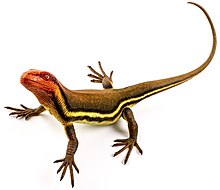Hylonomus
Hylonomus is an extinct stem tetrapod which lived 312 million years ago (mya) during the Pennsylvanian.[1] The lack of skull openings behind the eyes makes it difficult to decide whether or not it is a sauropsid. Westlothiana is older, but may have been an amphibian, and Casineria is rather fragmentary.
| Hylonomus Temporal range: Pennsylvanian,
| |
|---|---|

| |
| Model | |
| Scientific classification | |
| Domain: | Eukaryota |
| Kingdom: | Animalia |
| Phylum: | Chordata |
| Class: | Reptilia |
| Clade: | Romeriida |
| Genus: | †Hylonomus Dawson, 1860 |
| Type species | |
| †Hylonomus lyelli Dawson, 1860
| |
Hylonomus was 20 centimetres (8 in) long (including the tail) and probably would have looked rather similar to modern lizards. It had small sharp teeth and likely ate small invertebrates such as millipedes or early insects.[2]
Fossils of Hylonomus have been found in the remains of fossilized club moss stumps in Joggins Fossil Cliffs, Nova Scotia, Canada. The theory is that, after harsh weather, the club mosses would crash down. The stumps eventually hollow out. Small animals such as Hylonomus, seeking shelter, might enter and become trapped, starving to death. Fossils of the basal pelycosaur Archaeothyris and the basal diapsid Petrolacosaurus are also found in the same region of Nova Scotia, higher up, dated about 6 million years later.[1]
Some fossilized footprints, from about 315 mya, have been found in New Brunswick. They are attributed to Hylonomus.[3]
References
change- ↑ 1.0 1.1 Van Tuinen, Marcel; Hadly, Elizabeth A. (2004). "Error in estimation of rate and time inferred from the early Amniote fossil record and avian molecular clocks" (PDF). Journal of Molecular Evolution. 59 (2): 267–276. Bibcode:2004JMolE..59..267V. doi:10.1007/s00239-004-2624-9. PMID 15486700. S2CID 25065918. Retrieved 2009-09-02.
- ↑ Palmer D., ed. (1999). The Marshall Illustrated encyclopedia of dinosaurs and prehistoric animals. London: Marshall Editions. p. 62. ISBN 1-84028-152-9.
- ↑ Falcon-Lang H.J., Benton M.J. & Stimson M. 2007. Ecology of early reptiles inferred from Lower Pennsylvanian trackways. Journal of the Geological Society, London, 164, 6, 1113-1118. article[permanent dead link]